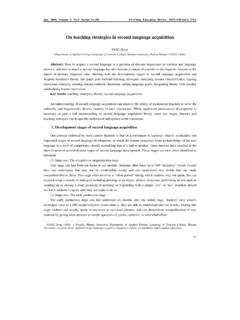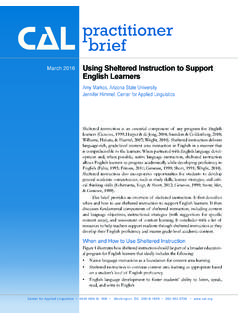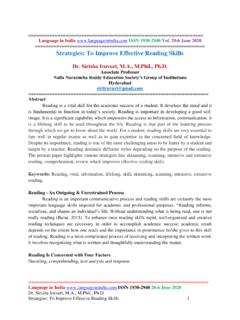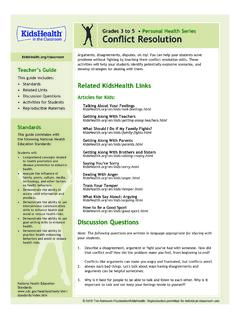Transcription of Language acquisition - Harvard University
1 Language acquisition 01:615:201 Introduction to Linguistic Theory Adam Szczegielniak Copyright in part: Cengage learning Language acquisition Language is extremely complex, yet children already know most of the grammar of their native Language (s) before they are five years old Children acquire Language without being taught the rules of grammar by their parents In part because parents don t consciously know the many of the rules of grammar What s Learned, What s Not? The innateness hypothesis asserts that children do not need to learn universal principles like structure dependency because that is part of UG They only have to learn the Language -specific aspects of grammar The innateness hypothesis provides an answer to Chomsky s question: What accounts for the ease, rapidity, and uniformity of Language acquisition in the face of impoverished data?
2 What s Learned, What s Not? An argument for the innateness hypothesis is the observation that we end up knowing more about Language than we hear around us This argument is known as the poverty of the stimulus Children are exposed to slips of the tongue, false starts, ungrammatical and incomplete sentences Also, children learn aspects of Language about which they receive no information Such as structure dependent rules The data the children is exposed to is impoverished What s Learned, What s Not? For example, children somehow know to invert the auxiliary of the main clause when forming a question like: Is the boy who is sleeping __ dreaming of a new car?
3 Rather than *Is the boy __ sleeping is dreaming of a new car? To do this, the child must somehow understand structure dependency and constituent structure, something that adults do not consciously know Stages in Language acquisition Children acquire Language in similar stages across the world When children are acquiring Language , they do not speak a degenerate form of adult Language Rather, they speak a version of the Language that conforms to the set of grammatical rules they have developed at that stage of acquisition The Perception and Production of Speech Sounds Infants display an ability to discriminate and recognize speech sounds They will even respond to linguistic contrasts when those contrasts are not present in the Language (s) spoken around them They can perceive differences in voicing, place of articulation, manner of articulation But they do not react to nonlinguistic aspects of speech (loudness, gender-based pitch differences, etc.)
4 The Perception and Production of Speech Sounds Infants appear to be born with the ability to perceive and focus on the sounds that are important for Language , so they can learn any human Language But by 6 months babies begin to lose to ability to discriminate between sounds that are not phonemic in the Language (s) they are acquiring Babbling Babbling begins at about 6 months and is considered the earliest stage of Language acquisition Babies may babble phonemes that do not occur in the Language (s) they are acquiring 95% of babble is composed of the 12 most common consonants around the world Early babbles mostly consist of CV sequences but become more varied later on By 1 year babbles are composed only of the phonemes used in the Language (s)
5 They hear Deaf babies babble with their hands like hearing babies babble using sounds First Words After the age of one, children figure out that sounds are related to meanings and start to produce their first words Usually children go through a holophrastic stage, where their one-word utterances may convey more meaning up used to indicate something in the sky or to mean pick me up This suggests that children know more Language than they can express Segmenting the Speech Stream A major obstacle that babies must overcome is to be able to identify where word boundaries are English-speaking children may be able to use stress as a cue for word boundaries (prosodic bootstrapping) Every content word in English has stress If a word has two syllables, the stress either falls on the first syllable (trochaic stress) or the second syllable (iambic stress)
6 , but the vast majority of English words have trochaic stress Experiments have shown that children do use stress as a cue for word boundaries since most English words have stress on the first syllable Segmenting the Speech Stream But how do children know the stress pattern of the Language they are acquiring? Babies may use statistical frequency of syllable sequences to determine word boundaries In one experiment, babies were able to recognize the nonsense words pabiku, tutibu, golabu, and babupu out of strings of nonsense syllables because those strings of syllables in the words occurred more frequently than the random strings of syllables Children may use statistical strategies to determine a few words, and from there may be able to determine the rhythmic, allophonic.
7 And phonotactic properties of the Language and then can determine even more words from this knowledge The acquisition of Phonology Children tend to acquire the sounds common to all languages first, followed by the less common sounds of their own Language Vowels tend to be acquired first, and consonants are ordered: Manner of articulation: nasals, glides, stops, liquids, fricatives, affricates Place of articulation: labials, velars, alveolars, palatals Uncommon but high frequency sounds may be acquired earlier than expected The acquisition of Phonology Children can perceive more sound contrasts than they can make in early stages Thus they know more about phonology than we can tell by listening to them speak When they cannot yet produce a sound, they may substitute an easier sound These substitutions are rule-governed Children tend to reduce consonant clusters ([pun] for spoon), reduplicate syllables ([wawa] for water), and drop final consonants ([ke] for cake)
8 The acquisition of Word Meaning When children learn the meanings of words they must learn the relevant features of the class of things that are referred to by that word They must learn that dog refers to pugs and Great Danes, but not cats When learning words, children often overextend a word s meaning For example, using the word dog to refer to any furry, four-legged animal (overextensions tend to be based on shape, size, or texture, but never color) They may also underextend a word s meaning For example, using the word dog to refer only to the family pet, as if dog were a proper noun The acquisition of Word Meaning The whole object principle.
9 When a child learns a new word, (s)he is likely to interpret the word to refer to a whole object rather than one of its parts This principle and others may help the child learn 5,000 words per year It has also been put forth that children can learn the meaning of verbs based on the syntactic environments of the verbs This is known as syntactic bootstrapping The acquisition of Morphology The acquisition of morphology clearly demonstrates the rule-governed nature of Language acquisition Children typically learn a morphological rule and then overgeneralize Children go through three stages in the acquisition of an irregular form.
10 In phase 1 they use the standard irregular past tense forms because they have learned these irregulars as separate lexical items (broke, brought) In phase 2 the child has learned the rule for past tense and therefore attaches the regular past tense morpheme to the irregular verb (breaked, bringed) In phase 3 the child realizes that there are exceptions to the morphological rule and bring the standard irregular forms back into their vocabulary (broke, brought) The acquisition of Morphology The wug test demonstrates that children apply the correct plural allomorph to nouns they have never heard before Which shows they have an understanding of natural classes of phonemes and are not just imitating words they have heard before Children acquiring languages other than English learn subject-verb agreement very early Children also demonstrate their knowledge of derivational rules and can create new words broomed ( swept )











![The Ontario Curriculum, Grades 1-8, Language [revised] 2006](/cache/preview/d/5/3/5/d/c/7/4/thumb-d535dc7439a04910d8a17bf7f1d6b83f.jpg)






